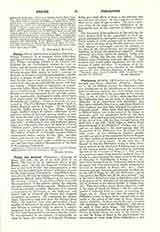

Philistines (Hebrew: PLSTYM; LXX philistieim in the Pentateuch and Josue, elsewhere allophuloit, “foreigners”). In the Biblical account the Philistines come into prominence as the inhabitants of the maritime plain of Palestine from the time of the Judges onward. They are mentioned in the genealogy of the nations (Gen., x, 14; cf. I Par., i, 11, 12), where together with the Caphtorim they are set down as descendants of Mesraim. It is conjectured with probability that they came originally from Crete, sometimes identified with Caphtor, and that they belonged to a piratical, seafaring people. They make their first appearance in Biblical history late in the period of the Judges in connection with the prophesied birth of the hero Samson. The angel appearing to Saraa, wife of Manue of the race of Dan, tells her that, though barren, she shall bear a son who “shall begin to deliver Israel from the hands of the Philistines” (Judges, xiii, 1-5); and we are informed in the same passage that the domination of the Philistines over Israel had lasted forty years. In the subsequent chapters graphic accounts are given of the encounters between Samson and these enemies of his nation who were encroaching upon Israel’s western border. In the early days of Samuel we find the Philistines trying to make themselves masters of the interior of Palestine, and in one of the ensuing battles they succeeded in capturing the Ark of the Covenant (I Kings, iv). The coming of a pestilence upon them, however, induced them to return it, and it remained for many years in the house of Abinadab in Cariathiarim (I Kings, v; vi; vii). After Saul became king the Philistines tried to break his power, but were unsuccessful, chiefly owing to the bravery of Jonathan (I Kings, xiii; xiv). Their progress was not, however, permanently checked, for we are told (I Kings, xiv, 52) that there was a “great war against the Philistines all the days of Saul“, and at the end of the latter’s reign we find their army still in possession of the rich plain of Jezrael including the city of Bethsan on its eastern border (I Kings, xxxi, 10). They met with a severe defeat, however, early in the reign of David (II Kings, v, 20-25), who succeeded in reducing them to a state of vassalage (II Kings, viii, 1). Prior to this date the power of the Philistines seems to have been concentrated in the hands of the rulers of the cities of Gaza, Ascalon, Azotus (Ashdod), Accaron, and Geth, and a peculiar title signifying “Lord of the Philistines” was borne by each of these petty kings. The Philistines regained their independence at the end of the reign of David, probably about the time of the schism, for we find the Kings of Israel in the ninth century endeavoring to wrest from them Gebbethon, a city on the border of the maritime plain (III Kings, xv, 27; xvi, 15). Towards the close of the same century the Assyrian ruler, King Adad-Nirari, placed them under tribute and began the long series of Assyrian interference in Philistine affairs. In Amos (i, 6, 8) we find a denunciation of the Philistine monarchies as among the independent kingdoms of the time.
During the latter part of the eighth century and during the whole of the seventh the history of the Philistines is made up of a continual series of conspiracies, conquests, and rebellions. Their principal foes were the Assyrians on the one side and the Egyptians on the other. In the year of the fall of Samaria (721 B.C.) they became vassals of Sargon. They rebelled, however, ten years later under the leadership of Ashdod, but without permanent success. Another attempt was made to shake off the Assyrian yoke at the end of the reign of Sennacherib. In this conflict the Philistine King of Accaron, who remained faithful to Sennacherib, was cast into prison by King Ezechias of Juda. The allies who were thus brought together were defeated at Eltekeh and the result was the siege of Jerusalem by Sennacherib (IV Kings, xviii—xix). Esarhaddon and Asurbanipal in their western campaigns crossed the territory of the Philistines and held it in subjection, and after the decline of Assyria the encroachments of the Assyrians gave place to those of the Egyptians under the Twenty-sixth Dynasty. It is probable that the Philistines suffered defeat at the hands of Nabuchodonosor, though no record of his conquest of them has been preserved. The old title “Lords of the Philistines” has now disappeared, and the title “King” is bestowed by the Assyrians on the Philistine rulers. The siege of Gaza, which held out against Alexander the Great, is famous, and we find the Ptolemies and Seleucids frequently fighting over Philistine territory. The land finally passed under Roman rule, and its cities had subsequently an important history. After the time of the Assyrians the Philistines cease to be mentioned by this name. Thus Herodotus speaks of the “Arabians” as being in possession of the lower Mediterranean coast in the time of Cambyses. From this it is inferred by some that at that time the Philistines had been supplanted. In the ebb and flow of warring nations over this land it is more than probable that they were gradually absorbed and lost their identity.
It is generally supposed that the Philistines adopted in the main the religion and civilization of the Canaanites. In I Kings, v, 2, we read: “And the Philistines took the ark of God, and brought it into the temple of Dagon, and set it by Dagon“, from which we infer that their chief god was this Semitic deity. The latter appears in the Tel el-Amarna Letters and also in the Babylonian inscriptions. At Ascalon likewise there was a temple dedicated to the Semitic goddess Ishtar, and as the religion of the Philistines was thus evidently Semitic, so also were probably the other features of their civilization.
JAMES F. DRISCOLL

